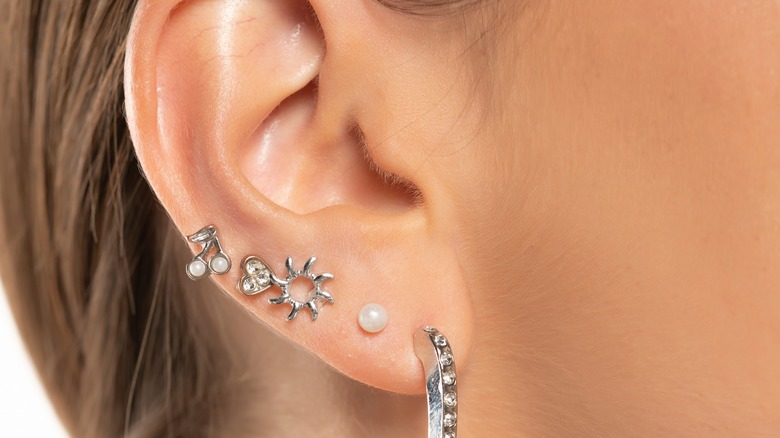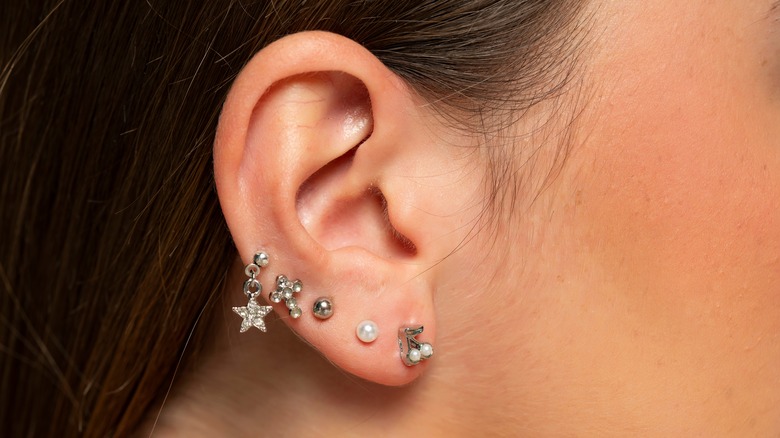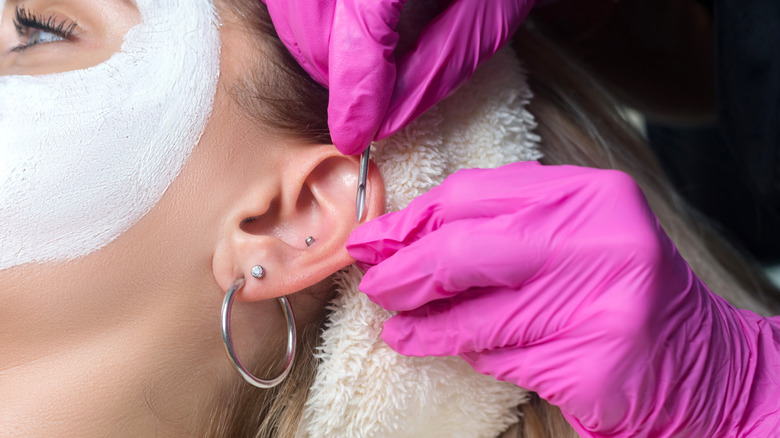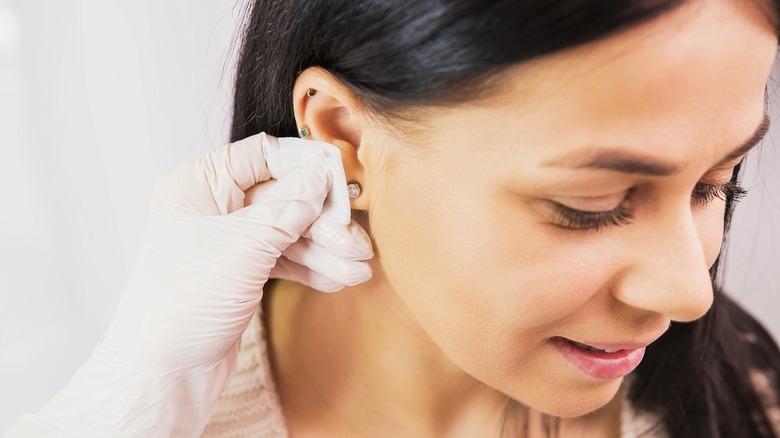Auricle Piercing: What Is It, And Why Is It So Dang Painful?
If you're a fan of body piercings, then you're surely well aware of the fact that they can add a stylish touch to your look, not to mention a vibe that's chic, eye-catching, and even edgy. Although that's certainly true of piercings on your nose, eyebrows, and hips — yes, hips — you may also be intrigued by an auricle piercing. On the other hand, if this is the first time you've heard of this particular piercing, that's likely for a very good reason. Frankly, although it's not exactly new to the world of body modifications, it is a term that hasn't been around for as long as some others.
"A lot of times, people start calling piercings things that we [professional piercers] don't. Like a Monroe, for example — I just call it a lip piercing," Brian Keith Thompson, a celebrity piercer and the owner of Los Angeles' Body Electric Studio, told Bustle while discussing auricle piercings.
Because they can be referred to by different names, it's important to know what exactly an auricle piercing is so that you can ensure that both you and the person who is doing the piercing are aware of what you want and what you'll end up with. Fortunately, we can fill you in on this particular piercing, as well as give you some info on why they can be so dang painful and how to make the process much more bearable.
You can curate stacks of earrings with auricle piercings
The first thing to know about an auricle piercing is that it's found on the outer edge of the ear. Although they're sometimes known as a helix, it's more specifically a type of helix that is placed below an upper helix and above a typical piercing that's on the earlobe, according to Fresh Trends. That's why this accent, which sits midway up your ear, is pretty much an essential addition if you want to curate the perfect stack of earrings. At the same time, because there's a relatively large space above the lobe, an auricle piercing can be in various spots along the rim of the ear. This is why you need to be sure exactly where you want one to be before you have it done. If you're getting one on each ear, your piercer will also want to make sure that they're perfectly level.
If you reach up to feel the space where the piercing will go, you should notice a hard section, which is due to the cartilage beneath the skin. Unfortunately, your new addition will have to go right through this. Your piercer will probably use a 14G or 16G needle to get the job done.
Although you might need a moment to take that in (because ew!), you should also know that the cartilage causes another issue that isn't exactly pleasant but is something that you can manage.
Cartilage and needle drag make auricle piercings painful
Anyone who's had their ears pierced knows that it can sting and burn for hours afterward. However, it's likely something that you can easily handle. As for auricle piercings, it's a different story. The issue has to do with cartilage. Since it's thicker and harder than the lobe, this spot is much more painful. Beyond that, celeb piercer Brian Keith Thompson explained to Refinery29 that the thick nature of the area can also cause friction, which means that the needle will experience an unpleasant drag.
Although getting the piercing done is certainly not completely unbearable, the discomfort that you'll endure doesn't end when the appointment is over. Cassi Lopez-March, the owner of So Gold Studios and former head body piercer at New York Adorned, told Refinery29 that you may have to wait anywhere from six to eight months for your piercings to finish healing. You might also have to put up with additional issues if you opt for the wrong kind of accessory. It's best to start with a stud, as Lopez-March pointed out the alternative — a hoop — isn't ideal, saying, "The diameter and thickness of the ring that would be needed for healing is not usually what people would want aesthetically. Rings also move a ton, which leads to irritation."
While that may sound more than just a little daunting, there are a few ways to make getting an auricle piercing easier and, surely more importantly, less painful.
How to make getting an auricle piercing more bearable
There's no denying the fact that auricle piercings can be ridiculously painful. In fact, all helix piercings are rough. Sophie, an editor at Cosmopolitan, admitted, "I'd had a helix piercing done before, back when I was 18, fainted outside the parlour and eventually had to discard of the cheap metal ring I'd put in (initially ignoring my sensitive skinned ways and the painful reaction)."
Although things didn't go well the first time around, Sophie decided to try again when she was older and took various steps to make the process less painful. Noting that she opted for a top-level piercer, she explained that the pro offered comfort, support, and helpful tips. They also had her laying back while the piercing was done, raised her up gradually when it was over, and gave her a sweet treat for the beneficial bump of sugar. Beyond that, she brought a friend along to hold her hand, which is always a good idea, especially since she was having two holes put in her ear.
"As I had both piercings done at once they started with the forward helix, which was the least painful of the two, maybe down to the fact that the cartilage is thinner there. They then worked outwards to the helix which was just as quick but I felt that pinch feeling a little more," Sophie recalled. She also noted, "I can safely say no fainting episodes this time around."



